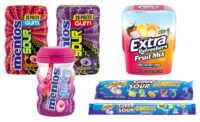Staying Tuned to the Challenges and Contradictions of Candy Retailing
Staying Tuned to the Challenges and
Contradictions of Candy Retailing
Mary Ellen Kuhn
About this time six years ago I was pondering the
wisdom of accepting the job I now hold as Confectioner’s editor.
I had a few reservations. After a decade spent covering the full spectrum
of food industry issues, I was concerned that reporting on only one segment
— albeit a sweet one — would be too limiting.
Little did I know! Not only is the confectionery
business immensely intriguing, but the fact that candy is distributed
across such a broad array of retail channels — way more than your
average food or beverage product — makes the process of covering it
continually challenging. Then there’s the way that the category
itself continues to evolve. After almost six years of watching this
business pretty closely, I’ve got a few thoughts about the trends and
issues that will be affecting all of us in the months ahead. So here goes.
• The line between sweets and snacks will
continue to blur. I hear that a number of chocolate/cookie hybrids are
in the pipeline for rollout in the next couple of months. And given
developments like Hershey’s acquisition of Mauna Loa late last year,
I wouldn’t be at all surprised to see more candy and nut combos on
supermarket shelves in the future.
• More and more candy makers will “get
it” on the matter of healthful product positioning. At the
recent NCA & ECRM EPPS Candy Marketplace, it was great to see that
Simply Lite Foods’ new line of fruit chews and gummies comes with
portion packs. Ask almost any dietitian; portion control is the way to go
for truly healthful eating. Snack makers already are mining the opportunity
for 100-calorie packs in a very big way, and our industry should be doing
something similar.
• Channel complexity will intensify. As if
this business of “channel blurring” could get any more
complicated! I’m pretty sure that’s where we’re headed,
however.
Take the much-pressured supermarket channel alone.
Within recent weeks we’ve seen news of chains like Marsh and Wegmans
moving their expansive and beautiful “lifestyle” stores into
new markets. At the other end of the spectrum, Food Lion has announced the
opening of its third Bottom Dollar store. (Love that name!) The stores
offer bargain-priced products in a no-frills, but upbeat and inviting
environment. Supervalu plans to debut a value-priced organic foods retail
outlet in Indianapolis in January, which is certainly an interesting niche
given that value pricing has not traditionally been associated with organic
foods.
The good news about all this: it means new
opportunities for retailers and vendors to merchandise well-targeted niche
products. The challenging part: vendors will need to be even sharper and
more flexible in order to effectively position products for the
increasingly complex array of retailing venues. As I’ve learned over
the past six years, this is not a simple business.
Looking for a reprint of this article?
From high-res PDFs to custom plaques, order your copy today!






